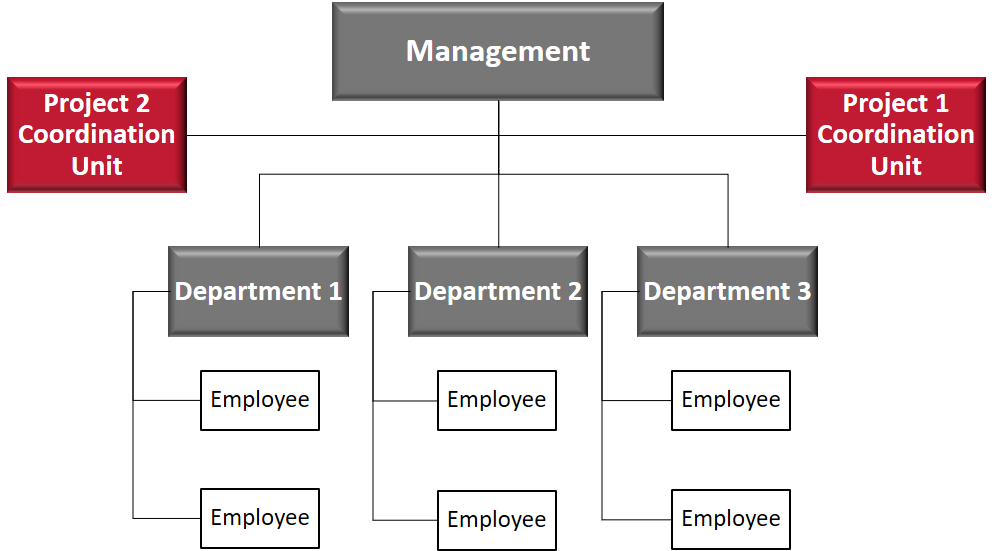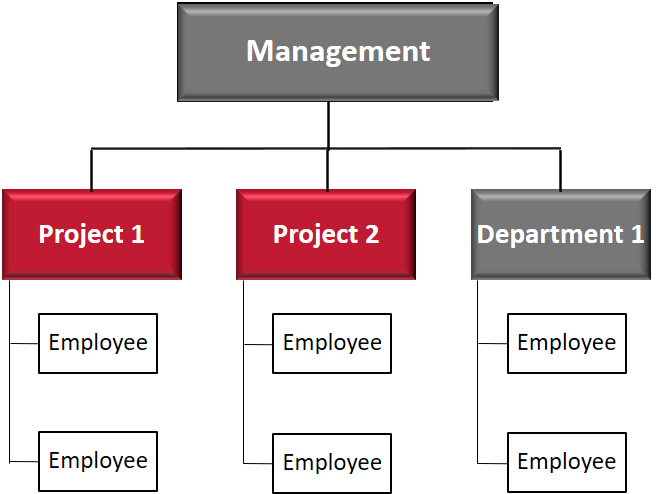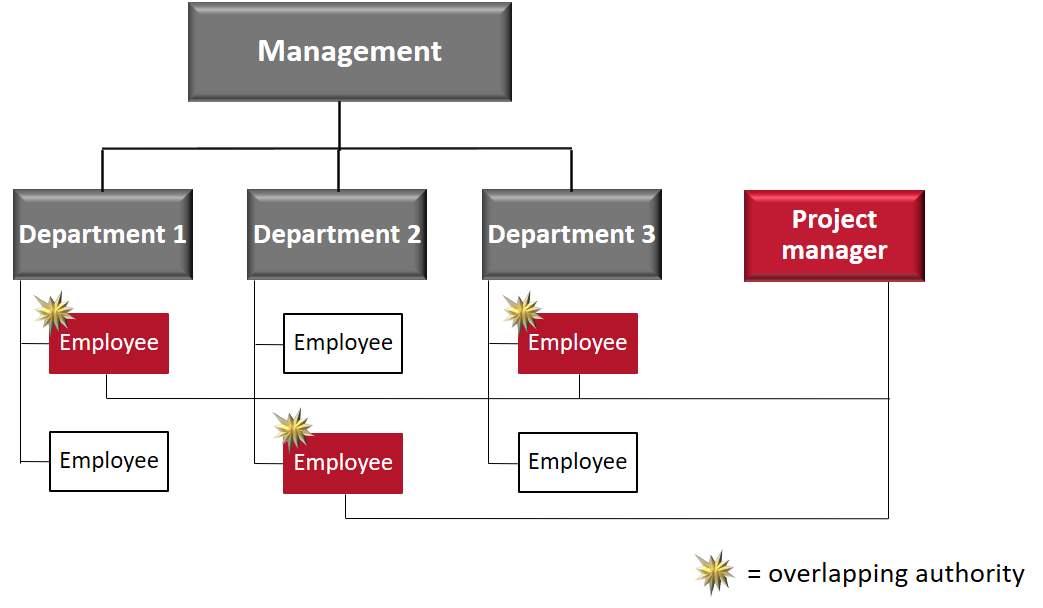Chapter 16 - Project Organisations¶
Part 2¶
Basic forms of project organisation¶
There are three basic forms of project management organisation:
- Functional (or staff) project organisation
- Pure (or autonomous or projectised) project organisation
- Matrix organisation
Functional project organisation¶
You as a project manager:
- Hold a staff position
- Don't have any authority to issue instructions to other units (only the authority to coordinate)
- Can only influence the project based on your technical ability and negotiating skills
- Don't make any important project decisions (therefore, you also don't have any responsibility for project deadlines, costs or outcome)
- Have the task to collect and to distribute information
- Must have unrestricted access to all project information
- Have low resource autonomy and low independence from the base organisation
Your job involves:
- Drawing attention to delays
- Preparing decisions
- Making recommendations to project team members
- Suggesting activities
The installation of a functional project management structure only constitutes a low level of organisational intervention. This organisation structure is often selected if a project will have an impact on many areas of a company (e.g. organisational projects such as the introduction of a company-wide software system or the installation of a quality management system) and on many or all of the company's employees.
Functional project management can also be effective in large-scale projects which involve many departments and necessitate extensive coordination activities, if you possess a high level of personal and professional authority. A project coordination unit with formal decision-making powers that reports directly to the board can quickly be overloaded so that it is unable to translate its decision-making powers into decisions. This often happens when the unit is responsible for the coordination of several projects at once. Many project managers simply assume unofficial powers in such situations so that they can keep the project going. They act pragmatically and make urgent decisions for which they do not have the formal authority (e.g. postponement of a milestone).

Advantages and disadvantages of functional project organisation:
| Pros | Cons |
|---|---|
Pure project organisation¶
You as a project manager:
- Are responsible for project decisions
- Are in charge of the organisational unit where all project team members work (internal as well as external)
- Usually are the technical and disciplinary superior of the project team members
- Are responsible for the project schedule, costs and quality
- Have the authority to make use of the human and material resources allocated to the project (the base organisation does not have free access to these resources)
→ Resource autonomy is high, as is the level of independence from the base organisation (i.e. there is no rivalry between project managers for scarce resources in the line)
In the past, such structures have often been used in large-scaled long-term armament projects.
In extreme cases, they take the form of project-specific single-purpose companies or own project companies.
In most cases project team members only receive instructions from you, their project manager, who is their technical and disciplinary superior. However, this does not apply in every case because an organisational hierarchy often exists below the level of the person in charge of the project in a project organisation. In large-scale projects, horizontal and vertical organisational sub-units are often established, such as sub-projects with sub-project managers (= internal structure).

Advantages and disadvantages of a pure project organisation:
| Pros | Cons |
|---|---|
→ risk that project capacities will not be used fully | |
Matrix organisation¶
The matrix organisation was used extensively by the aviation and aerospace industry in the early 1960s. Since there are many forms of matrix organisation, it is necessary to define the distribution of authority between the project manager and departmental managers on a project-by-project basis.
Distribution of authority
- Authority and responsibility are distributed between the departments (functional units) and the project organisation units.
- Project team members receive instructions from at least two units - if an employee is involved in several projects, a multiple command system exists which goes against the principle of single command.
- The conflict between departments and project manager, which is inevitable in such structures, is intentional.
- Supporters of the matrix organisation argue that it can actually be constructive because both viewpoints are taken into consideration when dealing with project problems.
Attention
However, conflicts can cause considerable problems for a project manager, for instance, if they demotivate the project team.

The distribution of authority between the departments and you can be simplified as follows:
- You are responsible for decisions concerning "what" and "when".
- The department head is responsible for decisions concerning "how" and "by whom".
Advantages and disadvantages of the matrix organisation:
| Pros | Cons |
|---|---|
How the story ends…¶
"Alright, thanks for the detailed description. In our case I would suggest organising the project in an autonomous form. I recommend it because the hay fever medication is a product which needs long time to be developed, produced and sold. This is an enormous project with many persons involved. It's important that you as a project manager can decide on your own without coordinating with line managers. Also, it's important that you allocate resources to the project otherwise the success of the project could be adversely affected. Of course, a pure project organisation comes along with some negative aspects, too. But in this case, I would say that the positive aspects predominate." Dr. Rogers nods approvingly: "Perfect, I have nothing more to add. Now all I have to do is talk to Mr. Bourges and see if he shares our view."